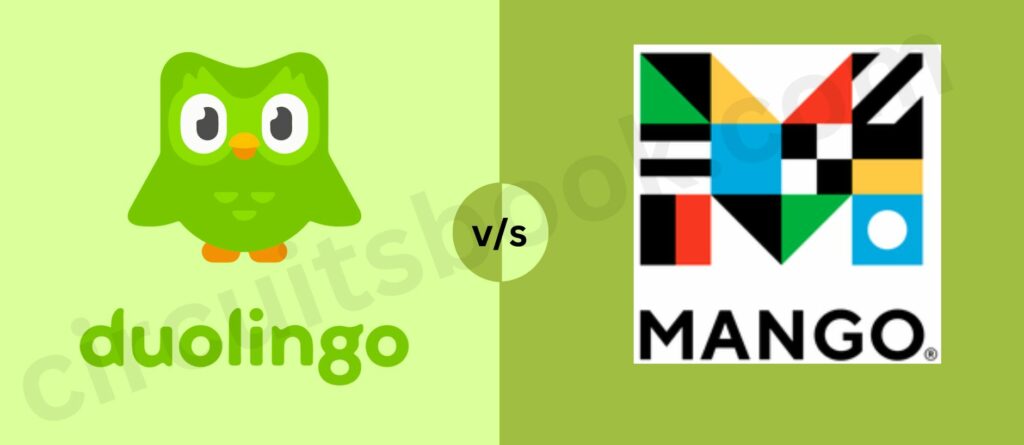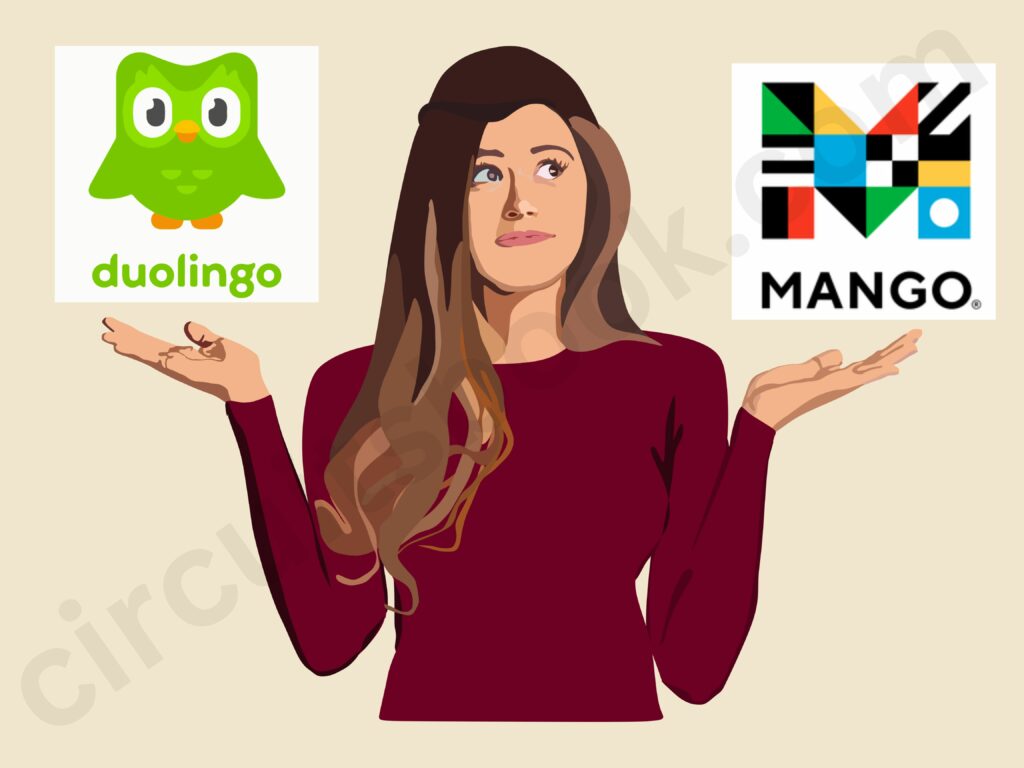Duolingo vs. Mango Languages: Which one to choose in 2024?
Duolingo is a platform that I always enjoy. However, relying on a single platform to learn a language is not worth it. Thus, I always look for other platforms to learn it. Whenever I choose a new platform, the first thing I do is to make a comparison between both of them. I am sure you also chose a platform after comparing them. Thus, here I am comparing the two most used platforms in the world of learning a language, which are Duolingo and Mango Languages. Want to know which one will win? Well, for that, read this detailed comparison between Duolingo vs. Mango Languages.
Quick Takeaways
- Duolingo is the platform that teaches the language in a more gamified approach. It has 40 languages with no grammar explanations.
- Mango languages is more like a conversation practice platform with grammatical knowledge. There are 70+ languages to offer.

What is Duolingo?
Duolingo is a platform that follows the gamified approach to teaching a new language. The exercises on the platform are more like a game. It makes sure that we stay engaged with the content. There are a lot of features that motivated me to learn the language. In short, it’s a perfect platform to learn the language properly.
What is Mango languages?
Mango Languages provides high-quality content to learn the language. Its main aim is “organic language acquisition”, due to which there is no grammar on it. With the help of this platform, I was able to have a meaningful conversation with the other native speakers.
Duolingo vs. Mango Languages: What are the main differences?
Despite being a language learning platform, both platforms are different from each other. Here are the common differences between them-
1. Number of languages
Duolingo is a platform that helps to learn over 40 languages. Whereas, the number of languages for Mango languages is much more than 70. Here is the table that represents the common languages on both platforms-
| French | English | Polish | Latin | Noreegian |
| Italian | Japanese | Russian | Czech | Farsi |
| German | Hindi | Greek | Finnish | Dutch |
2. Pricing
Duolingo is a platform that offers all the content freely. All the exercises are free to use. However, there is a subscription plan known as Super Duolingo). It is used to get unlimited hearts and remove the ads. Honestly, I have used it once but I didn’t prefer it. The pricing of the platforms depends upon two plans-
- Duolingo Individual plan
- Duolingo family plan
Individual Plan is the one which is only offered for a single person at a time. The cost for this plan depends upon the duration of the plan. Below I have mentioned the subscription plan of the platform-

| Countries | Subscription plan |
| U.S.A | $6.99 a month |
| UK | £6.49 a month |
| Australia | $10.83 a month |
| Canada | $8.91 a month. |
Duolingo Family plan is the plan that allows you to share the subscription with multiple other members. It can be shared by up to 6 members. Thus, if you are having people who want to use it, try to take a family plan. The pricing for it is again based on the duration of the plan. The table added below is the representation of the prices for family plans based on different countries-
| Country | Price of the plan |
| US | $119.99 |
| UK | £105.99 |
| Canada | $149.99 |
| Australia | $174.99 |
| EU | €122.99 |
Whereas if I talk about Mango Languages, there is limited free content. To enjoy the contempt fully, I had to take the subscription plan. The pricing of the plan depends upon the type and duration of it. Following is the table that represents the cost of the plan-

| Types of plans | Single languages | All languages | Enterprise |
| Monthly | $11.99 per month | $19.99 per month | Depends upon the customizing |
| Annualy | $119.99 ($9.99 per month) | $199.99 ($16.67 per month) | Depends upon the customizing |
3. Vocabulary section
Duolingo earlier has a vocabulary section available on the desktop version. But with time the platform removed it. However, we can still find the Duolingo vocabulary flashcards through Anki and Memrise. On the other hand, Mango Languages has a separate tab to learn the words and phrases. Of course, I will discuss a little more in further sections.
How does Duolingo teach the language?
Duolingo involves gamified elements to teach the language. Once, a language is selected, the first thing to do is to decide whether to take the Duolingo placement test or not. This test helps determine where we stand. If you are an absolute beginner, skip the test. After that, the platform follows a specific learning path. This path is the updated version of the previous Duolingo tree. In this path, the course is divided into different sections. Each section is a set of units. These units further involve different lessons. Each lesson has a set of exercises. The lessons are too short to go through. They are only 10–15 minutes long.

Each exercise is a game in itself. You play and win some points. Some of the common exercises that I got were Matching the pairs, Choosing the correct option, pronunciation, etc. At the end of each unit, there is a legendary level, that made me understand whether I have learned the unit properly. During my learning journey, what I always looked to win was Duolingo gems.
In addition to the gems, there were XP scores. These points were used to win the leagues. Leagues are another interesting feature that Duolingo uses to learn the language properly. They are basically a competition, where I had to compete with the other learners.
How do Mango languages teach the language?
The working of the mango languages is somewhere like Duolingo’s learning path. There are different units containing chapters and chapters containing lessons. But the way of teaching is different. The free version only allowed me to take the first three lessons of the very first unit. However, the subscription plan allowed me to choose the topic (unit) of my choice.
After choosing it, now is the time to select the chapter. For instance, I choose the lifestyle unit for me. In it, there were multiple lessons. I chose one of them based on the name of them. Each lesson is a combination of the conversation and the grammar goals. Depending upon the choice I made, the lessons were there. I choose the conversational goals.
There were pre-recorded conversations between two people and the tab gave the meaning of each conversation. I have to record the translations of it. It also has cultural notes in it and helped me to learn more about the culture.

Another tab is the vocabulary tab. This tab will only have the words once we complete the lessons. The words from the lessons are covered in this section. I could also add words by myself to the list.
Quick Comparison
I have created a table below, which discusses a quick comparison between two platforms-
| Factors | Duolingo | Mango Languages |
| Number of languages | 40+ | 70+ |
| Pricing | Starting from $6.99 | Starting from $11.99 |
| Vocabulary list | No | Yes |
Duolingo vs. Mango Languages: Which one is for you?
Now the reason for which we are here – which one to choose. I generally believe that both platforms follow similar approaches. However, both of them are different from each other. The lessons are short but the way they are taught are different from each other. On Duolingo, there are words on the screen and select the translations.

Whereas, in Mango languages, the teaching style was different. You get the choice to select whether to select the conversational or grammar goal. I chose the conversational practice. In it, the lesson was created in the manner that two people are talking to each other. If you want to practice conversation, choose the mango languages. On the other hand, Duolingo is more like learning new words and sentences.
What are the benefits and drawbacks of using Duolingo?
No platform only has benefits in it. Duolingo is also the same to it. Here is the table that shows the pros and cons of it-
| Pros | Cons |
| Games like exercises | Less grammatical lessons |
| Best for beginner | No content for advanced learners |
| The platform is free to use | |
| Features to make you motivated |
What are the benefits and drawbacks of using Mango languages?
Here are the pros and cons of using Mango languages-
| PROS | CONS |
| A lot of interactive lessons | Less content for advanced learners |
| Cultural and grammar notes | Google translation tool does not work with it |
| Conversations based on real-life scenarios |

Alternatives
Both platforms are best in their own ways. But it may not be a perfect approach for you. Thus, I have shared some alternatives following different learning approaches-
1. iTalki – Finding a live tutor
iTalki is the platform that teaches the language through live tutors. There are multiple tutors for a specific language. It has two types of tutors- Community and Professionals. Community tutors are the ones, who do not have prior teaching experience. On the other hand, Professionals are the ones who have some teaching experience. Despite not having a degree or experience, community tutors are still a great choice for a person who is on a tight budget.
2. Cooljugator – Learning verb conjugations
Both the above platforms do not offer grammar rules. Cooljugator is a platform that focuses on a specific grammar aspect – verb conjugation. It helps to know how to use the verb in different situations. The verb conjugation is done based on the following factors-
- Person used
- Numbers
- Tenses
- Voices
- Situations etc
3. U-talk – For visual learners
uTalk offers lessons and exercises with the help of visuals on the screen. The visual with the audio is there. Listen to them and get the gamed-based exercises. The exercises helped me to remember the meaning of the new words that I learned. It has a huge library of topics to choose from. Just select it, and get some exciting exercises.

Conclusion
The winner of the comparison between Duolingo and Mango Languages depends on your learning approach. I honestly enjoy both platforms. One helped me learn all the basic words and vocabulary using a gamified approach. On the other hand, the second platform helped me with conversational practice. Thus, decide what you want and go with that platform. However, just remember that both platforms fail to provide advanced-level learning content.
FAQs
Can you get fluent in mango languages?
No, you can not get fluent with this platform alone. To get fluent, we must get advanced level content. As Mango languages do not have it, the platform can not make you fluent.
Can you get fluent with Duolingo?
No, you can not get fluent with Duolingo solely. Try to use some additional resources to get fluent in the language.


